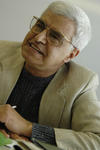There's Magic in Them There Squares
Ask Professor of Mathematics Hossein Behforooz about magic squares, and his eyes light up like . . . well, like magic.
Magic squares are tables of numbers arranged in such a way that the rows, columns, and diagonals all add up to the same number. Legend has it that magic squares were discovered by the Chinese emperor Yu in 2200 B.C. Yu was reportedly walking along the bank of the Yellow River, and came upon a turtle whose shell was pierced with a series of dots and spots. Assigning numbers to the grid produced the Lo-Shu magic square (see Figure 1), where the sum of each of the three rows, each of the three columns, and each of the two diagonals is 15.
Today, 4200 years later, magic squares are found in nearly every culture in the world. Studied and created by mathematicians and hobbyists alike, magic squares have, according to Behforooz, no practical application. Some, however, believe that magic squares have mystical powers, which is why in some countries magic squares can be found in and on temples, in jewelry and body art, and in pottery and other hand-crafted items.
"The Process is a Mystery" He brings out magic square after magic square, some he has developed himself, others that have been documented in books. "I will show you so many ways [to create magic squares] that you will say 'Wow,'" he says, eyes shining.
One such piece is his eight by eight magic square with 64 U.S. election years from 1788 to 2040. He notes that the numbers on each row, column and bend diagonal add up to 15,312 (see Figures 2-5).
A second example is a four by four "mirror magic square." The columns, rows, and diagonals add up to 242. Switch the digits in each cell, and the columns, rows, and diagonals still add up to 242.
"Why is the word 'magic' in there?" he asks rhetorically. "The process is a mystery."
An Early Addiction Behforooz says that he became enamored of magic squares as a student in junior high school. While waiting in a barber shop to get his hair cut, he found in a magazine a four-by-four square table with some of the cells already filled in with numbers. The challenge was to fill the remaining cells with other numbers in such a way that the four rows, the four columns, and the two diagonals would add up to 34.
Behforooz found the solution and filled in the remaining cells. A few minutes later, while getting his hair cut, he noticed himself in the mirror. "I saw my eyes wide open from excitement," he recalls. "Then I loved this subject and have worked on it continuously since then."
He pulls out a magic square he created as an undergraduate student at Tehran University. Based on the so-called Franklin square created by Benjamin Franklin, the piece is 32 by 32 squares, and the neatly-written numbers are in blue, red, and black ink. "I was so excited when I finished that big table," he says, asking that his picture be taken with his creation.
For all of their complexity, Behforooz insists that one need not be a mathematician to study or create magic squares. Rather, he says, a person must have focus and drive. "There is nothing special about the words 'be,' 'not,' 'to,' and 'or,' he says. "But only William Shakespeare put those words together into that famous phrase, 'To be or not to be.'"
"Sometimes you can write a lovely love letter in 10 minutes," he continues. "Sometimes you cannot write the letter in 10 months. That's why it's magic."
Behforooz, who has taught at Utica College since 1987, has given a number of talks on magic squares, including Nexus Seminars, a Faculty Research Day seminar, and Math Club lectures. In addition to magic squares, he lists his interests as traveling, reading, gardening, and "being a good neighbor to my elderly neighbors."


